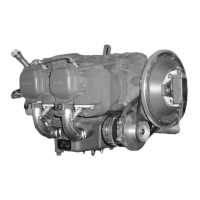LYCOMING OPERATOR’S MANUAL SECTION 3
O-320 SERIES OPERATING INSTRUCTIONS
a. Head the aircraft into the wind.
b. Leave mixture in “Full Rich”.
c. Operate only with the propeller in minimum blade angle setting.
d. Warm-up at approximately 1000-1200 RPM. Avoid prolonged idling and do not exceed 2200 RPM on
the ground.
e. Engine is warm enough for take-off when the throttle can be opened without the engine faltering.
6. GROUND CHECK.
a. Warm-up as directed above.
b. Check both oil pressure and oil temperature.
c. Leave mixture in “Full Rich”.
d. (Where applicable) Move propeller control through its complete range to check operation and return
to full low pitch position. Full feathering check (twin engine) on the ground is not recommended but
the feathering action can be checked by running the engine between 1000-1500 RPM; then
momentarily pulling the propeller control into the feathering position. Do not allow the RPM to drop
more then 500 RPM.
e. A proper magneto check is important. Additional factors, other than the ignition system, affect
magneto drop-off. They are load-power output, propeller pitch and mixture strength. The important
thing is that the engine runs smoothly because magneto drop-off is affected by the variables listed
above. Make the magneto check in accordance with the following procedures.
(1) Controllable Pitch Propeller. When propeller in minimum pitch angle, set the engine to produce
50-65% power as indicated by the manifold pressure gage. Mixture control should be in the full
rich position. At these settings, the ignition system and spark plugs must work harder because of
the greater pressure within the cylinders. Under these conditions ignition problems, if they exist,
will occur. Mag checks at low power settings will only indicate fuel-air distribution quality.
NOTE
Aircraft that are equipped with fixed pitch propellers, or not equipped with manifold
pressure gage, may check magneto drop-off with engine operating at a maximum of
2000/2100 RPM.
(2) Switch from both magnetos to one and note drop-off, return to both until engine regains speed and
switch to the other magneto and note drop-off, then return to both. Drop-off should not exceed 175
RPM and should not exceed 50 RPM between magnetos. A smooth drop-off past normal is usually
a sign of a too lean or too rich mixture.
f. Do not operate on a single magneto for too long a period, a few seconds is usually sufficient to check
drop-off and will minimize plug fouling.
3-3

